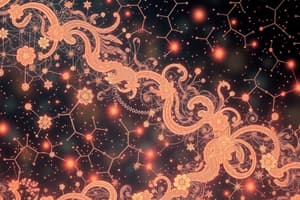Podcast
Questions and Answers
How does the Kinetic Particle Theory describe the arrangement of matter?
How does the Kinetic Particle Theory describe the arrangement of matter?
- Only gases are composed of small particles, while liquids and solids are not.
- Matter consists of large, visible particles that don't move.
- Matter is made of varying sized particles with no uniformity.
- All matter is made up of very small invisible particles. (correct)
What effect does increasing temperature have on particle movement according to the Kinetic Particle Theory?
What effect does increasing temperature have on particle movement according to the Kinetic Particle Theory?
- Temperature has no effect on particle movement.
- Particles move slower as temperature increases.
- Particle collision rates decrease with temperature.
- Particles gain more energy and move faster. (correct)
In terms of gas diffusion, which statement is true?
In terms of gas diffusion, which statement is true?
- Lighter gas particles diffuse more quickly than heavier ones. (correct)
- Heavier gas particles diffuse faster than lighter ones.
- Gas particles are unable to fill available volume.
- All gas particles move at the same speed regardless of mass.
What is an example of diffusion as described in the content?
What is an example of diffusion as described in the content?
Which point in the heating curve represents the transformation from solid to liquid?
Which point in the heating curve represents the transformation from solid to liquid?
When water is heated to boiling, what happens at point D?
When water is heated to boiling, what happens at point D?
What does Brownian motion illustrate about particles in a fluid?
What does Brownian motion illustrate about particles in a fluid?
Which statement correctly describes the concept of solubility?
Which statement correctly describes the concept of solubility?
Which gas will diffuse faster under equal conditions?
Which gas will diffuse faster under equal conditions?
What happens to the rate of diffusion when the temperature of a gas increases?
What happens to the rate of diffusion when the temperature of a gas increases?
Which process occurs when a solid dissolves in a solvent?
Which process occurs when a solid dissolves in a solvent?
Which mixture can be separated by diffusion at a specific temperature?
Which mixture can be separated by diffusion at a specific temperature?
What state of matter changes between points A and B in a cooling gas graph?
What state of matter changes between points A and B in a cooling gas graph?
When a perfume bottle is left open, which combinations of processes allow the scent to spread throughout the room?
When a perfume bottle is left open, which combinations of processes allow the scent to spread throughout the room?
Which of the following best describes the diffusion of gases?
Which of the following best describes the diffusion of gases?
What significant effect does a gas's relative molecular mass have on its rate of diffusion?
What significant effect does a gas's relative molecular mass have on its rate of diffusion?
What occurs to the volume of a gas when the temperature decreases?
What occurs to the volume of a gas when the temperature decreases?
Which of the following describes an exothermic change?
Which of the following describes an exothermic change?
What happens to energy during the process of condensation?
What happens to energy during the process of condensation?
In terms of mixtures, what is a characteristic of a solution?
In terms of mixtures, what is a characteristic of a solution?
Which term describes substances that do not dissolve in a particular solvent?
Which term describes substances that do not dissolve in a particular solvent?
What is the term for a mixture containing small particles of an insoluble solid spread throughout a liquid?
What is the term for a mixture containing small particles of an insoluble solid spread throughout a liquid?
Which statement accurately describes a saturated solution?
Which statement accurately describes a saturated solution?
What do the weak attractive forces acting between molecules refer to?
What do the weak attractive forces acting between molecules refer to?
Flashcards are hidden until you start studying
Study Notes
Diffusion
- Ammonia (NH3) particles have a lower mass than Hydrogen Chloride (HCl) particles, so they diffuse faster.
- The white smoke (NH4Cl) forms closer to the Hydrochloric acid (HCl) because the ammonia (NH3) diffuses faster.
- The lower the relative molecular mass of a gas, the faster the gas diffuses.
- When a gas is heated, its particles move faster as they gain energy.
- Heating a gas causes faster diffusion due to increased collisions between particles.
- Diffusion can be used to separate mixtures of gases with different diffusion rates.
- Diffusion can also be used to explain why an open bottle of perfume can be smelt across a room.
States of Matter
- The graph represents the change of state from a solid (ice) to a liquid (water) to a gas (steam).
- At point B (on the graph) the change of state from solid to liquid occurs.
- At point B the temperature remains constant until all the solid ice has changed into liquid water.
- At point D the change of state from liquid to gas occurs.
- At point D the temperature remains constant until all the liquid water has changed into gas (water vapor) at 100 °C.
- A decrease in temperature of a gas produces a decrease in volume. The gas contracts.
Changes of State
- Condensation involves the release of energy as particles come closer together.
- Freezing involves the release of energy as particles come closer together.
Energy and Changes of State
- Exothermic changes release heat energy.
- Endothermic changes absorb heat energy.
Mixtures
- A mixture is formed when two or more substances are mixed together but not chemically combined.
- The substances in a mixture can be separated by physical means.
- A solution is a mixture of a solute and a solvent.
- A solute is the substance that dissolves in the solvent to form a solution.
- A solvent is the substance that dissolves the solute to form a solution.
- Water is the most common solvent.
- Solubility is a measure of how much solute can dissolve in a solvent at a particular temperature.
Solutions
- A saturated solution contains the maximum amount of solute that can dissolve in a solvent at a given temperature.
- Concentration refers to the amount of solute dissolved in a solvent.
Brownian Motion
- Brownian motion is the random motion of particles in a suspension.
- Brownian motion is caused by invisible particles colliding with visible particles.
The Kinetic Particle Theory
- All matter is made up of small, invisible particles.
- Each element is composed of its own type of atom.
- Atoms of different elements can combine to make the molecules of a compound.
- The speed of particles depends on their mass and temperature.
- Lighter particles move faster than heavier particles at the same temperature.
- Gases can fill any volume because their particles are free to move anywhere.
Other Concepts
- Alloys are mixtures of elements (usually metals) with properties suitable for a specific purpose.
- A suspension is a mixture containing small particles or droplets suspended throughout a liquid.
- A precipitation reaction forms an insoluble salt from solutions of two soluble salts.
Studying That Suits You
Use AI to generate personalized quizzes and flashcards to suit your learning preferences.




